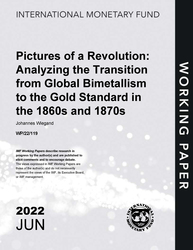
Pictures of a Revolution: Analyzing the Transition from Global Bimetallism to the Gold Standard in the 1860s and 1870s
Pictures of a Revolution: Analyzing the Transition from Global Bimetallism to the Gold Standard in the 1860s and 1870s
READ MORE...
Volume/Issue:
Volume 2022
Issue 119
Publication date: June 2022
ISBN: 9798400212208
$20.00
Add to Cart by clicking price of the language and format you'd like to purchase
Available Languages and Formats
| English |
Prices in red indicate formats that are not yet available but are forthcoming.
Topics covered in this book
This title contains information about the following subjects.
Click on a subject if you would like to see other titles with the same subjects.
Economics- Macroeconomics , Money and Monetary Policy , Economics / General , Bimetallism , Gold Standard , France , Germany , Gold share , Bimetallism's robustness , estimating specie demand , structural limit , share of silver coin , Gold , Silver , Currencies , Currency reform , Stocks , Global
Also of interest
Summary
In the early 1870s, the global monetary system transitioned from bimetallism—a regime in which gold and silver currencies were tied at quasi-fixed exhange ratios—to the gold standard that was characterized by the use of (only) gold as the main currency metal by the largest and most advanced economies. The transition ocurred against the backdrop of both large supply shifts in global bullion markets in the 1850s and 60s and momentous political events, such as the Franco-Prussian war of 1870/71 and the subsequent foundation of the German empire. The causes for the transition have long been a matter of intense debate. This article discusses three separate but interrelated issues: (i) assessing the robustness of the pre-1870 bimetallic system to shocks—which includes a discussion of the appropriate use of Flandreau’s (1996) reference model; (ii) analyzing the transition from bimetallism to gold as a multi-stage currency game played by France and Germany; and (iii) evaluating the monetary debates at the German Handelstag conferences in the 1860s, to present a more complete narrative of the German discussion in the run-up to the transition.
Copyright © 2010 - 2026
Powered by:
AIDC



